反义疑问句规则 详解
- 格式:doc
- 大小:39.00 KB
- 文档页数:3
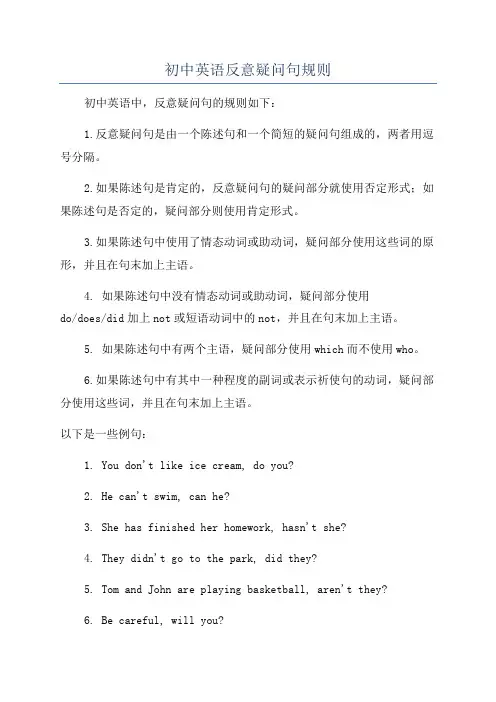
初中英语反意疑问句规则
初中英语中,反意疑问句的规则如下:
1.反意疑问句是由一个陈述句和一个简短的疑问句组成的,两者用逗号分隔。
2.如果陈述句是肯定的,反意疑问句的疑问部分就使用否定形式;如果陈述句是否定的,疑问部分则使用肯定形式。
3.如果陈述句中使用了情态动词或助动词,疑问部分使用这些词的原形,并且在句末加上主语。
4. 如果陈述句中没有情态动词或助动词,疑问部分使用
do/does/did加上not或短语动词中的not,并且在句末加上主语。
5. 如果陈述句中有两个主语,疑问部分使用which而不使用who。
6.如果陈述句中有其中一种程度的副词或表示祈使句的动词,疑问部分使用这些词,并且在句末加上主语。
以下是一些例句:
1. You don't like ice cream, do you?
2. He can't swim, can he?
3. She has finished her homework, hasn't she?
4. They didn't go to the park, did they?
5. Tom and John are playing basketball, aren't they?
6. Be careful, will you?。
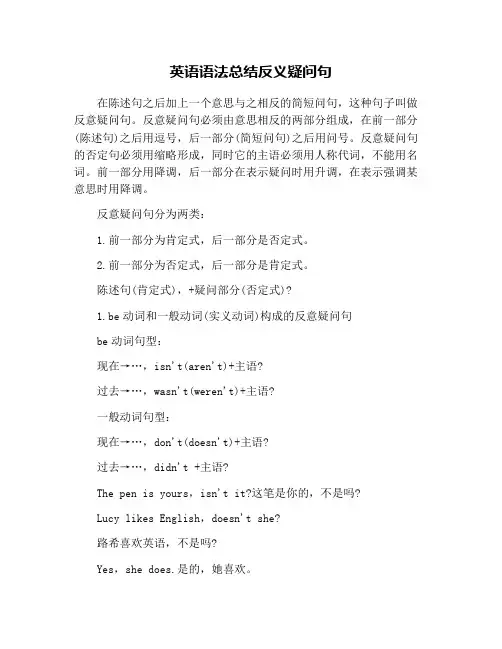
英语语法总结反义疑问句在陈述句之后加上一个意思与之相反的简短问句,这种句子叫做反意疑问句。
反意疑问句必须由意思相反的两部分组成,在前一部分(陈述句)之后用逗号,后一部分(简短问句)之后用问号。
反意疑问句的否定句必须用缩略形成,同时它的主语必须用人称代词,不能用名词。
前一部分用降调,后一部分在表示疑问时用升调,在表示强调某意思时用降调。
反意疑问句分为两类:1.前一部分为肯定式,后一部分是否定式。
2.前一部分为否定式,后一部分是肯定式。
陈述句(肯定式),+疑问部分(否定式)?1.be动词和一般动词(实义动词)构成的反意疑问句be动词句型:现在→…,isn't(aren't)+主语?过去→…,wasn't(weren't)+主语?一般动词句型:现在→…,don't(doesn't)+主语?过去→…,didn't +主语?The pen is yours,isn't it?这笔是你的,不是吗?Lucy likes English,doesn't she?路希喜欢英语,不是吗?Yes,she does.是的,她喜欢。
No,she doesn't.不,她不喜欢。
That was a wonderful night,wasn't it?那是个奇妙的夜晚,不是吗?Yes,it was.是的,它是。
No,it wasn't.不,它不是。
Your sister helped him,didn't she?你姐姐协助了他,不是吗?Yes,she did.是的。
她协助他。
No,she didn't.不。
她没有协助他。
注意反意疑问句中,前后两部分的动词在人称、数和时态上通常保持一致。
另外后一部分的人称代词应和前一部分的主语(名词或代词)保持一致。
Tom is skating,isn't he?(实行时)汤姆在滑冰,不是吗?Yes,he is.是的。
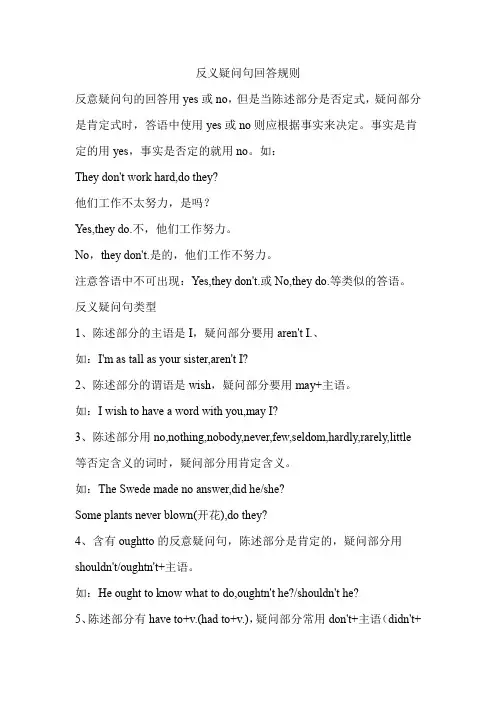
反义疑问句回答规则反意疑问句的回答用yes或no,但是当陈述部分是否定式,疑问部分是肯定式时,答语中使用yes或no则应根据事实来决定。
事实是肯定的用yes,事实是否定的就用no。
如:They don't work hard,do they?他们工作不太努力,是吗?Yes,they do.不,他们工作努力。
No,they don't.是的,他们工作不努力。
注意答语中不可出现:Yes,they don't.或No,they do.等类似的答语。
反义疑问句类型1、陈述部分的主语是I,疑问部分要用aren't I.、如:I'm as tall as your sister,aren't I?2、陈述部分的谓语是wish,疑问部分要用may+主语。
如:I wish to have a word with you,may I?3、陈述部分用no,nothing,nobody,never,few,seldom,hardly,rarely,little 等否定含义的词时,疑问部分用肯定含义。
如:The Swede made no answer,did he/she?Some plants never blown(开花),do they?4、含有oughtto的反意疑问句,陈述部分是肯定的,疑问部分用shouldn't/oughtn't+主语。
如:He ought to know what to do,oughtn't he?/shouldn't he?5、陈述部分有have to+v.(had to+v.),疑问部分常用don't+主语(didn't+主语)。
如:We have to get there at eight tomorrow,don't we?6、陈述部分的谓语是usedto时,疑问部分用didn't+主语或usedn't+主语。
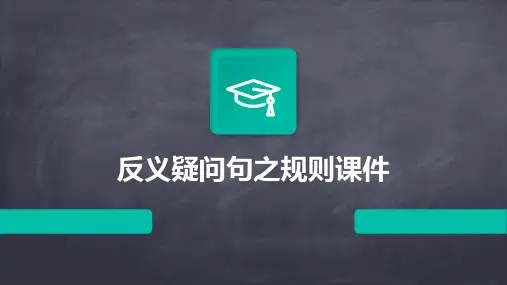
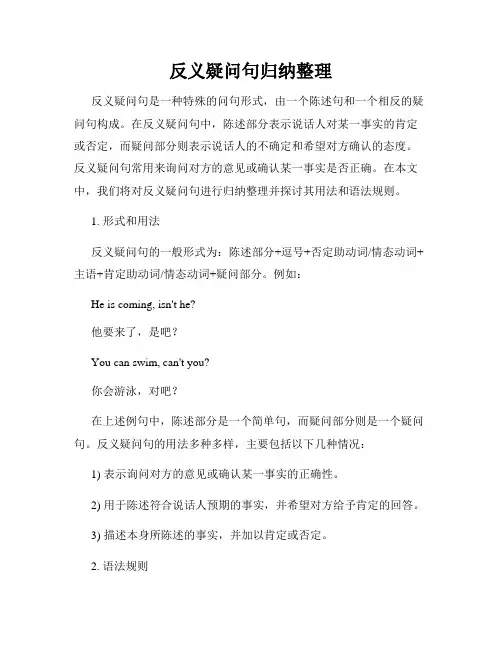
反义疑问句归纳整理反义疑问句是一种特殊的问句形式,由一个陈述句和一个相反的疑问句构成。
在反义疑问句中,陈述部分表示说话人对某一事实的肯定或否定,而疑问部分则表示说话人的不确定和希望对方确认的态度。
反义疑问句常用来询问对方的意见或确认某一事实是否正确。
在本文中,我们将对反义疑问句进行归纳整理并探讨其用法和语法规则。
1. 形式和用法反义疑问句的一般形式为:陈述部分+逗号+否定助动词/情态动词+主语+肯定助动词/情态动词+疑问部分。
例如:He is coming, isn't he?他要来了,是吧?You can swim, can't you?你会游泳,对吧?在上述例句中,陈述部分是一个简单句,而疑问部分则是一个疑问句。
反义疑问句的用法多种多样,主要包括以下几种情况:1) 表示询问对方的意见或确认某一事实的正确性。
2) 用于陈述符合说话人预期的事实,并希望对方给予肯定的回答。
3) 描述本身所陈述的事实,并加以肯定或否定。
2. 语法规则在构成反义疑问句的过程中,需要遵循一些语法规则,以确保句子的正确性和逻辑性。
2.1 句子主语在反义疑问句中,疑问部分的主语通常与陈述部分一致。
例如:She likes ice cream, doesn't she?她喜欢冰淇淋,对吧?You have finished your homework, haven't you?你完成了作业,是吧?2.2 肯定和否定疑问部分的肯定或否定助动词/情态动词取决于陈述部分的肯定或否定。
如果陈述部分是肯定的,疑问部分的助动词/情态动词是否定形式,反之亦然。
例如:He doesn't like chocolate, does he?他不喜欢巧克力,对吧?They can't swim, can they?他们不会游泳,是吧?2.3 时态和语态反义疑问句的时态和语态一般与陈述部分保持一致。
例如:She has been to Paris, hasn't she?她去过巴黎,是吧?The book wasn't written by him, was it?这本书不是他写的,对吧?3. 总结反义疑问句是一种特殊的问句形式,常用来询问对方的意见或确认某一事实的正确性。
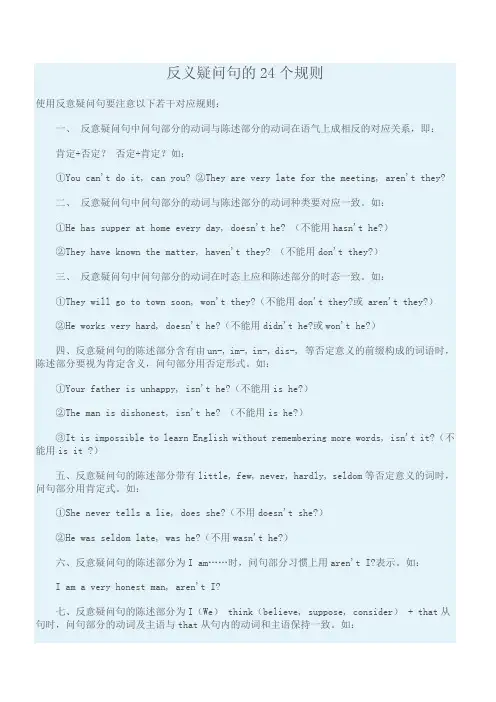
反义疑问句的24个规则使用反意疑问句要注意以下若干对应规则:一、反意疑问句中问句部分的动词与陈述部分的动词在语气上成相反的对应关系,即:肯定+否定?否定+肯定?如:①You can't do it, can you? ②They are very late for the meeting, aren't they?二、反意疑问句中问句部分的动词与陈述部分的动词种类要对应一致。
如:①He has supper at home every day, doesn't he?(不能用hasn't he?)②They have known the matter, haven't they? (不能用don't they?)三、反意疑问句中问句部分的动词在时态上应和陈述部分的时态一致。
如:①They will go to town soon, won't they?(不能用don't they?或 aren't they?)②He works very hard, doesn't he?(不能用didn't he?或won't he?)四、反意疑问句的陈述部分含有由un-, im-, in-, dis-, 等否定意义的前缀构成的词语时,陈述部分要视为肯定含义,问句部分用否定形式。
如:①Your father is unhappy, isn't he?(不能用is he?)②The man is dishonest, isn't he? (不能用is he?)③It is impossible to learn English without remembering more words, isn't it?(不能用is it ?)五、反意疑问句的陈述部分带有little, few, never, hardly, seldom等否定意义的词时,问句部分用肯定式。
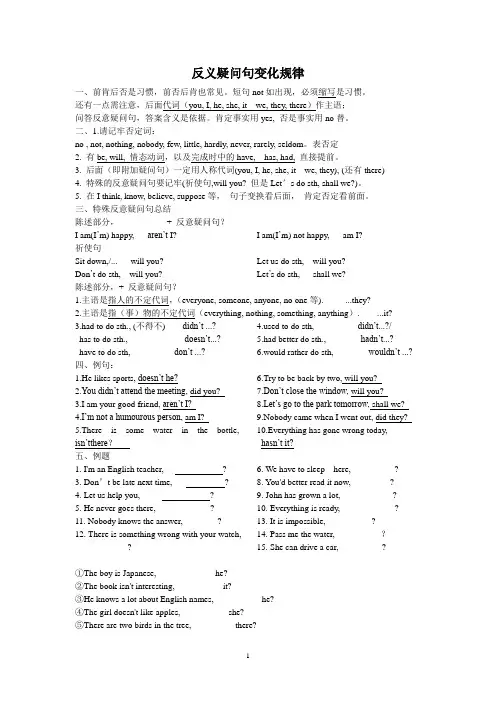
反义疑问句变化规律一、前肯后否是习惯,前否后肯也常见。
短句not如出现,必须缩写是习惯。
还有一点需注意,后面代词(you, I, he, she, it we, they, there)作主语;问答反意疑问句,答案含义是依据。
肯定事实用yes, 否是事实用no替。
二、1.请记牢否定词:no , not, nothing, nobody, few, little, hardly, never, rarely, seldom。
表否定2. 有be, will, 情态动词,以及完成时中的have, has, had, 直接提前。
3. 后面(即附加疑问句)一定用人称代词(you, I, he, she, it we, they), (还有there)4. 特殊的反意疑问句要记牢(祈使句,will you? 但是Let’s do sth, shall we?)。
5. 在I think, know, believe, suppose等,句子变换看后面,肯定否定看前面。
三、特殊反意疑问句总结陈述部分,+ 反意疑问句?I am(I’m) happy, aren’t I? I am(I’m) not happy, am I?祈使句Sit down,/... will you? Don’t do sth, will you? Let us do sth, will you? Let’s do sth, shall we?陈述部分,+ 反意疑问句?1.主语是指人的不定代词,(everyone, someone, anyone, no one等). ...they?2.主语是指(事)物的不定代词(everything, nothing, something, anything). ...it?3.had to do sth., (不得不) didn’t ...? has to do sth., doesn’t...? have to do sth, don’t ...?ed to do sth, didn’t...?/5.had better do sth., hadn’t...?6.would rather do sth, wouldn’t ...?四、例句:1.He likes sports, doesn’t he?2.You didn’t attend the meeting, did you?3.I am your good friend, aren’t I?4.I’m not a humourous person, am I?5.There is some water in the bottle, isn’tthere?6.Try to be back by two, will you?7.Don’t close the window, will you?8.Let’s go to the park tomorrow, shall we?9.Nobody came when I went out, did they?10.Everything has gone wrong today, hasn’t it?五、例题1. I'm an English teacher, _____________?3. Don’t be late next time,____________?4. Let us help you, _____________?5. He never goes there, ____________?6. We have to sleep here,__________?8. You'd better read it now,_________?9. John has grown a lot, ___________ ?10. Everything is ready, ____________?11. Nobody knows the answer, _______ ?12. There is something wrong with your watch, ____________? 13. It is impossible, __________?14. Pass me the water, _________ ?15. She can drive a car, _________ ?①The boy is Japanese, _____________he?②The book isn't interesting, __________ it?③He knows a lot about English names, __________ he?④The girl doesn't like apples, __________ she?⑤There are two birds in the tree, _________ there?⑥The man came to China last month, ________ he?(1)You’re a farmer, _______ ________?(2)The weather isn’t fine, _______ _______?(3)Kate came here last month, _______ _______?(5)There weren’t enough nuts, _______ _______?(6)There’s a pen in the pencil-box, _______ ________?(7)The man had bread for lunch, _________ _______?(8)Mary can speak little English , ________ ________?(9)Nothing is wrong with the watch, _______ _______?1. There is little meat on the plate, ________________?2. Tom had to walk home, ________?3. Mary is singing now, ___________?4. Mr. Smith was reading , _________?5. He has never been there, _______?6. They will go swimming, _________?7. This isn’t a desk, ___________?8. These are apples, ___________?9. She’s gone, ____________?10. She’s very angry, ___________?1.There is something wrong with the bike,_______ _______?2.Something is wrong with the bike,________ ______?3.They usually have lunch at 12 o’clock, _______ ______?4. He had to stop playing computer games, ________ _______?5. You have never been to Beijing, _______ _______?6. Everybody is ready, ________ _________?7. Let’s finish it together, ________ ________?8. Stand up, ________ _______?9. I’m not foolish, _______ ________?10. You had better make it six, ______ _____?1. They have dinner at six every day,____________?2. Tom had to walk home, ___________?3. Don’t play with fire, _____________?4. Mr. Smith was reading , ___________?5. He has never been there, __________?6. They will go swimming, ____________?7. This isn’t a desk, ___________?8. Everything is here, ___________?9. There are many apples on the tree, ____________?10. Let’s play football, ___________?。
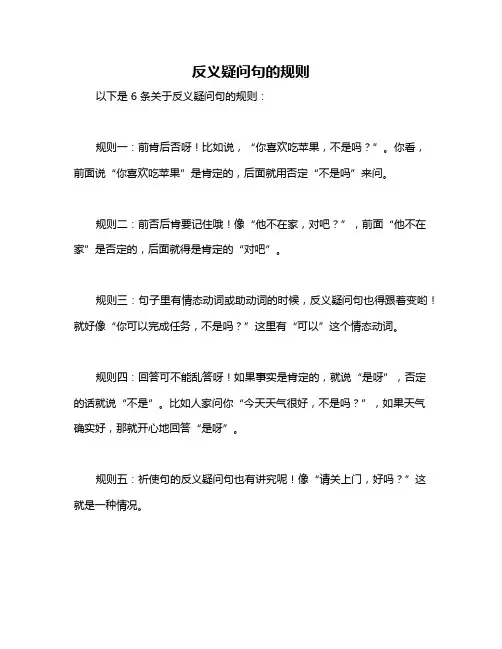
反义疑问句的规则
以下是 6 条关于反义疑问句的规则:
规则一:前肯后否呀!比如说,“你喜欢吃苹果,不是吗?”。
你看,前面说“你喜欢吃苹果”是肯定的,后面就用否定“不是吗”来问。
规则二:前否后肯要记住哦!像“他不在家,对吧?”,前面“他不在家”是否定的,后面就得是肯定的“对吧”。
规则三:句子里有情态动词或助动词的时候,反义疑问句也得跟着变哟!就好像“你可以完成任务,不是吗?”这里有“可以”这个情态动词。
规则四:回答可不能乱答呀!如果事实是肯定的,就说“是呀”,否定的话就说“不是”。
比如人家问你“今天天气很好,不是吗?”,如果天气确实好,那就开心地回答“是呀”。
规则五:祈使句的反义疑问句也有讲究呢!像“请关上门,好吗?”这就是一种情况。
规则六:否定前移的句子要注意后面的反义疑问句怎么问哟!“我觉得你不对,是吗?”就是这样的例子。
我觉得反义疑问句挺有意思的呀,学会了这些规则,咱就能更好地用它啦!。
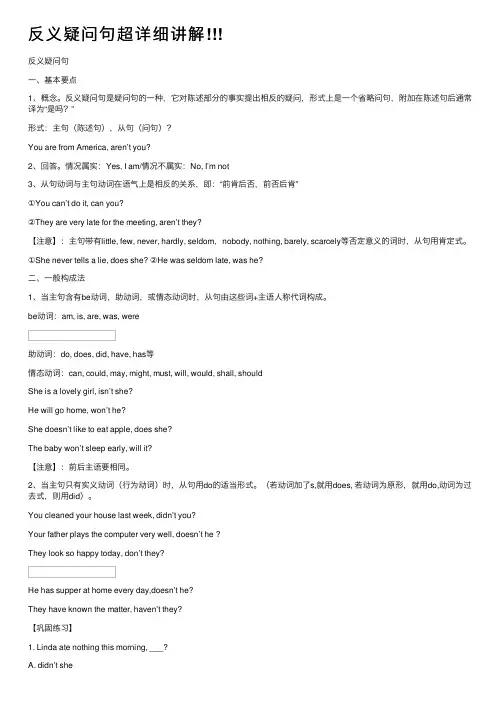
反义疑问句超详细讲解反义疑问句⼀、基本要点1、概念。
反义疑问句是疑问句的⼀种,它对陈述部分的事实提出相反的疑问,形式上是⼀个省略问句,附加在陈述句后通常译为“是吗?”形式:主句(陈述句),从句(问句)?You are from America, aren’t you?2、回答。
情况属实:Yes, I am/情况不属实:No, I’m not3、从句动词与主句动词在语⽓上是相反的关系,即:“前肯后否,前否后肯”①You can’t do it, can you?②They are very late for the meeting, aren’t they?【注意】:主句带有little, few, never, hardly, seldom,nobody, nothing, barely, scarcely等否定意义的词时,从句⽤肯定式。
①She never tells a lie, does she? ②He was seldom late, was he?⼆、⼀般构成法1、当主句含有be动词,助动词,或情态动词时,从句由这些词+主语⼈称代词构成。
be动词:am, is, are, was, were助动词:do, does, did, have, has等情态动词:can, could, may, might, must, will, would, shall, shouldShe is a lovely girl, isn’t she?He will go home, won’t he?She doesn’t like to eat apple, does she?The baby won’t sleep early, will it?【注意】:前后主语要相同。
2、当主句只有实义动词(⾏为动词)时,从句⽤do的适当形式。
(若动词加了s,就⽤does, 若动词为原形,就⽤do,动词为过去式,则⽤did)。
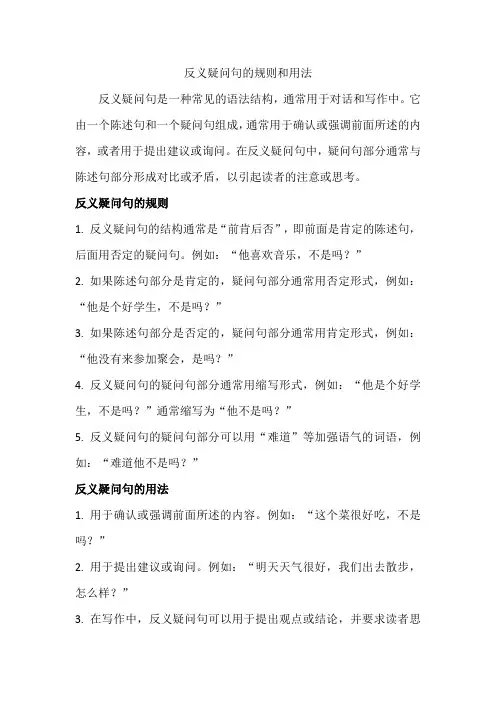
反义疑问句的规则和用法
反义疑问句是一种常见的语法结构,通常用于对话和写作中。
它由一个陈述句和一个疑问句组成,通常用于确认或强调前面所述的内容,或者用于提出建议或询问。
在反义疑问句中,疑问句部分通常与陈述句部分形成对比或矛盾,以引起读者的注意或思考。
反义疑问句的规则
1. 反义疑问句的结构通常是“前肯后否”,即前面是肯定的陈述句,后面用否定的疑问句。
例如:“他喜欢音乐,不是吗?”
2. 如果陈述句部分是肯定的,疑问句部分通常用否定形式,例如:“他是个好学生,不是吗?”
3. 如果陈述句部分是否定的,疑问句部分通常用肯定形式,例如:“他没有来参加聚会,是吗?”
4. 反义疑问句的疑问句部分通常用缩写形式,例如:“他是个好学生,不是吗?”通常缩写为“他不是吗?”
5. 反义疑问句的疑问句部分可以用“难道”等加强语气的词语,例如:“难道他不是吗?”
反义疑问句的用法
1. 用于确认或强调前面所述的内容。
例如:“这个菜很好吃,不是吗?”
2. 用于提出建议或询问。
例如:“明天天气很好,我们出去散步,怎么样?”
3. 在写作中,反义疑问句可以用于提出观点或结论,并要求读者思
考或回应。
例如:“难道我们应该容忍这种行为吗?”
4. 在口语中,反义疑问句可以用于加强语气或表达情感。
例如:“难道你不觉得这样做很过分吗?”
反义疑问句是一种常见的语法结构,在对话和写作中都有广泛的应用。
通过使用反义疑问句,我们可以确认或强调前面所述的内容,提出建议或询问,或者在写作中提出观点或结论,并要求读者思考或回应。
同时,在口语中,反义疑问句也可以用于加强语气或表达情感。
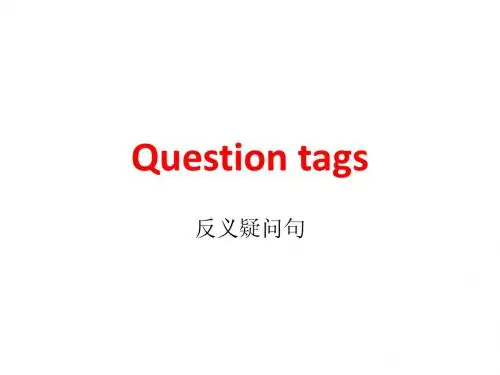
反义疑问句的构成及用法解析反义疑问句是由两个部分组成的复合句结构,一部分是陈述句,另一部分是疑问句。
反义疑问句用于表示说话者的疑问、请求、邀请、建议等语气,通常在陈述句后面用一个简洁的疑问句形式进行追问。
本文将对反义疑问句的构成以及用法进行解析。
一、反义疑问句的构成反义疑问句的构成相对简单,通常由主句和附属疑问句两部分组成。
1. 主句:主句是陈述句,表达说话者的主观判断、陈述或提问。
2. 附属疑问句:附属疑问句通常由一个简单的疑问句构成,用来追问或引导对主句所述内容的确认。
二、反义疑问句的用法1. 强调说话者的疑问态度:反义疑问句常用于表达说话者对所说内容的疑问,加强语气,使句子更具有说服力。
例如:- You don't like coffee, do you?- The weather is beautiful today, isn't it?2. 提出请求或邀请:通过反义疑问句的形式,可以在陈述句后面提出请求或邀请,给对方以选择的机会。
例如:- Please help me with this, will you?- Let's go for a walk, shall we?3. 提供建议或提出建议:反义疑问句还可以用于提供建议或向对方提出建议。
例如:- We should study harder, shouldn't we?- You could try talking to him, can't you?4. 表达对事实的确认:反义疑问句也可以用来确认某些已知或普遍事实。
例如:- You went to the party last night, didn't you?- He speaks English, doesn't he?三、使用注意事项1. 反义疑问句的附属疑问句应根据主句的语气和时间态势,使用正确的助动词形式。
例如,在陈述句中使用了助动词 "do",则附属疑问句中应使用相应的助动词形式。
反义疑问句的用法归纳及回答举例初中
摘要:
一、反义疑问句的用法归纳
1.反义疑问句的构成
2.反义疑问句的回答方式
3.反义疑问句的注意事项
二、反义疑问句的回答举例
1.肯定回答举例
2.否定回答举例
正文:
一、反义疑问句的用法归纳
1.反义疑问句的构成
反义疑问句通常由两部分组成:一个陈述句和一个简短的疑问句。
陈述句和疑问句之间通常有一个逗号分隔,而且疑问句部分常常以“难道不是吗?”等反问语气词结尾。
例如:“你不喜欢吃苹果,难道不是吗?”
2.反义疑问句的回答方式
当反义疑问句用于询问对方意见时,回答时要根据事实情况给出肯定或否定的回答。
如果事实情况与陈述句一致,回答为肯定;如果事实情况与陈述句相反,回答为否定。
例如,对于“你不喜欢吃苹果,难道不是吗?”这个问题,如果对方确实不喜欢吃苹果,回答应该是“是的,我不喜欢。
”
3.反义疑问句的注意事项
在使用反义疑问句时,要注意陈述句和疑问句的一致性。
如果陈述句是肯定形式,疑问句部分也应该是肯定形式;如果陈述句是否定形式,疑问句部分也应该是否定形式。
此外,反义疑问句通常用于表示对某事不确定或想要得到对方确认的情况下,所以要根据实际情况适当使用。
二、反义疑问句的回答举例
1.肯定回答举例
张三问:“你不喜欢吃苹果,难道不是吗?”
李四回答:“是的,我不喜欢。
”
2.否定回答举例
张三问:“你不喜欢吃苹果,难道不是吗?”
李四回答:“不,我喜欢吃苹果。
英语中的反义疑问句反义疑问句(The Disjunctive question),即附加疑问句。
它表示提问人的看法,没有把握,需要对方证实。
反义疑问句由两部分组成:前一部分是一个陈述句,后一部分是一个简短的疑问句,两部分的人称和时态应该保持一致。
(数。
)反义疑问句的规则:●1, 前肯后否或前否后肯Eg. They work hard , don’t they ?You didn’t go , did you ?●2, 前后人称,时态和数的一致。
一.当主语是不定代词everyone , no one , nobody 等时,后面的疑问词应表示为:Everyone is in the classroom , aren’t they ?(基本不用单数)Nobody will go ,will they ?二,everything , anything ,nothing , something 时,附加疑问句中主语一般用it 和they●3,特殊句型否定意义的词一,当陈述部分有never , seldom ,hardly , few , little , barely , scarcely , noting 等否定意义的词时,后面的反义疑问句则为肯定形式。
Eg. There are few apples in the basket , are there ?He can hardly swim , can he ?二,当陈述部分含有否定意义的词是:unhappy , dislike , unfriendly , 等含有否定词缀的派生词,也就是有un-前缀,-less后缀等含有词缀而意思否定的词,当作肯定句处理,疑问句部分要用否定形式。
Eg. He looks unhappy , doesn’t he ?The girl dislike history , doesn’t she ?4,表示主语主观愿望的词含有think , believe , suppose ,imagine ,expect 等动词后接宾语从句构成的主从复合句在构成反义疑问句时,视情况有两种不同的构成方式。
反义疑问句1)“am I”的否定形式是“aren’t I”,而不是“am not I”或“amn’t I”。
例如:I am right, aren’t I?2)everything和nothing作为陈述句的主语时是单数,因此反意疑问句中的主语要用“it”。
注意,nothing作为主语时,反意疑问句中的动词要用肯定形式。
例如:Nothing is wrong, is it?3)陈述句中的主语为everyone, everybody, anyone, nobody或no one时,反意疑问句中的主语用they。
注意,nobody和no one是否定词,因此反意疑问句应该用肯定的。
例如:Nobody knows it, do they?4)如果陈述句部分有no, never, hardly, scarcely, rarely, seldom等词,那么,陈述句本身就是否定的,所以要接一个肯定的反意疑问句。
例如:He has never been there, has he?5)如果陈述句中的动词是“wish”,那么反意疑问句中要用“may”。
例如:I wish to go there with you, may I?6)包括听话人在内时“let’s”的反意疑问句要用“shall we”。
反之,反意疑问句中要用“will you”。
例如:Let’s go, shall we?Let us go, will you?全真模拟试题1. All of the plants now farmed on a large scale were developed from plants ____ wild.A. that once growB. once they growC. they once grewD. once grew2. By the time you graduate, we ____ in Australia for one year.A. will be stayingB. will have stayedC. would have stayedD. have stayed3. He appreciated ____ the chance to deliver his thesis in the annual symposium on Comparative Literature.A. having givenB. to have been givenC. to have givenD. having been given4. The government official can hardly find sufficient grounds ____his arguments in favor of the revision of the tax law.A. on which to baseB. which to be based onC. to base on whichD. on which to be based5. Living in the desert involves a lot of problems, ____water shortage is the worst.A. not to mentionB. of whichC. let aloneD. for what6. Hydrogen is one of the most important element in the universe ____ it provides the building blocks from which the other elementsare produced.A.so thatB. but thatC. provided thatD. in that7. Just as relaxation is an important part of our lives, ____stress.A.so isB. as it isC. and so isD. the same is8. Victor took a bus and headed for home, ____ if his wife would have him back.A. not to knowB. not knownC. not knowingD. not having known9. We can make an exception ____.A. in any case of JohnB. in case of JohnC. in case of John’sD. in the case of John10. When the Cultural Revolution was launched in China, his father ______ college.A. attendedB. had been attendingC. was attendingD. has been attending11. My cat is a fussy eater, but my dog is so ____ that she’ll swallow down anything that is put in front of her.A. indiscriminateB. choosyC. indefiniteD. picky12. “This house is more ____than the federal government!” Mac complained to his parents. “You have rules for everything.”A. systematicB. democraticC. bureaucraticD. public试题答案与解析1. A)【句意】大规模种植的农作物都繁衍于野生植物。
反义疑问句(一)概念:反意疑问句是由陈述句和附在其后的附加疑问句(be动词、助动词、情态动词+ 主语)组成。
其中附加疑问句是对陈述句所说的事实或观点提出疑问,起证实作用,一般用于证实说话者所说的事实或观点。
(二)要点注意:1、反意疑问句前后两部分谓语应是:“肯定陈述+否定疑问”或“否定陈述+肯定疑问”。
2、附加疑问句如果是否定式:not应与be,do,will等be动词、助动词、情态动词缩写。
3、附加疑问句的主语不用名词,应用人称代词。
4、陈述部分含“too...to”时,是否定句。
(三)用法:1) 陈述部分I am时,疑问部分要用aren't I.I'm as tall as your sister,aren't I?(我和你姐姐一样高,对吗?)2)当陈述部分是I wish…时,疑问部分通常用may II wish to go with them, may I? 我想同他们一起去,可以吗?3)当陈述部分为为there be句型时,疑问部分仍用there作“主语”:There was nothing in the room, was there? 房间里什么也没有,是吗?There will not be any trouble, will there?4)陈述部分主语是不定代词everybody(one), anyone (body), somebody (one), nobody, no one 等合成不定代词时,疑问部分常用复数they,有时也用单数he.Everyone knows the answer, don't they? (doesn’t he?)Nobody knows about it, do they? (does he?)5)陈述部分主语是指示代词或不定代词everything, something, nothing, anything, this, that, 疑问部分主语用it。
反意疑问句的构成规则反意疑问句是英语中一种常见的语法结构,它由一个陈述句和一个对该陈述句提出的相反的疑问句构成。
本文将介绍反意疑问句的基本构成规则,帮助读者更好地理解和运用该语法结构。
一、基本构成规则1. 构成方式:反意疑问句由陈述句的主谓倒装和一个疑问句构成。
2. 助动词的选择:根据陈述句的情态动词或助动词的类型,选择相应的助动词构成反意疑问句。
3. 主谓一致原则:反意疑问句的疑问部分的主谓要与陈述部分保持一致。
二、陈述句的类型与对应构成形式1. 陈述句为肯定句:陈述句为肯定句时,对应的反意疑问句采用否定疑问句的形式。
例如:He is a student, isn't he?(他是学生,不是吗?)2. 陈述句为否定句:陈述句为否定句时,对应的反意疑问句采用肯定疑问句的形式。
例如:She doesn't like coffee, does she?(她不喜欢咖啡,对吗?)3. 陈述句含有情态动词:陈述句含有情态动词时,将这个情态动词作为助动词构成反意疑问句。
例如:They can swim, can't they?(他们会游泳,是吗?)4. 陈述句为一般疑问句:陈述句为一般疑问句时,对应的反意疑问句保持一般疑问句的形式。
例如:You are a student, aren't you?(你是学生,不是吗?)5. 陈述句为祈使句:陈述句为祈使句时,对应的反意疑问句使用Let's或Shall we构成。
Open the window, will you?(打开窗户,好吗?)三、一些特殊情况的处理方式1. 句子中含有主语"nobody"、"nothing"、"no one"等时,构成反意疑问句时将这些词替换为"anybody"、"anything"、"anyone"。
反义疑问句应用规则
一、英文中的反意疑问句。
1、什么是反意疑问句
英语中,反意疑问句是由陈述句和附在其后的附加疑问句组成。
其中附加疑问句是对陈述句所说的事实或观点提出疑问,起证实作用,一般用于证实说话者所说的事实或观点。
翻译为“是吗”
2.反意疑问句的回答,回答时,如果情况属实,用Yes加上反问句的倒装肯定句;若果情况不属实,则用No加上反问句的倒装否定句。
例如
A) You were moved by your students, weren’t you? (你被学生推动了,是吗?)
情况属实:Yes, I were. (是的,我是)
情况不属实:No, I weren’t.(不,我没有。
)
B) You aren’t a student, are you? (你不是学生,是吗?)
情况属实:Yes, I am. (不,我是。
)
情况不属实:No, I am not. (是的,我不是。
)
二、反意疑问句中问句部分的动词与陈述部分的动词在语气上成相反的对应关系,即:肯定+否定?否定+肯定?如:
三.当陈述句中含有be动词,助动词,或是情态动词时,反问句部分由这些词加上主语人称代词构成,
Be动词包括:am, is, are, was, were
助动词有:do, does, did, have(用在完成时), has(用在完成时)等
情态动词有:can, could, may, might, must, will, would, shall, should
四.当陈述句中只含有行为动词时,若动词加了s,就用does, 若动词为原形,就用do,动词为过去式,则用did,例如:
五.反意疑问句的陈述部分带有little, few, never, hardly, seldom,nobody, nothing, barely, scarcely等否定意义的词时,问句部分用肯定式。
如:
六、反意疑问句的陈述部分为I am……时,问句部分习惯上用aren’t I?表示。
七.陈述部分的主语为不定代词something, anything, nothing, everything时,问句部分的主语用it。
如:
八、陈述部分的主语为不定代词somebody (someone), anybody (anyone), nobody (no one), everybody (everyone)时,问句部分的主语用he或they,这时问句动词的数应和he或they一致。
如:
九.陈述部分为祈使句
1)若为let’s引导,反问句用shall we? 例如
2)若为let us引导和其余的任何一般的否定祈使句,都用will you, 例如
3)一般的肯定祈使句则用will you 或won’t you 都行,例如:
十:陈述部分为There (Here) + be + 主语时,问句部分用动词+there (here)?形式。
练习:
1、You can’t do it, ____ _____?
你不能做它,是吗?
2、They are very late for the meeting, ______ ______?
他们开会迟到了,是吗?
3、She is a lovely girl, ______ _______?
她是一个可爱的女孩,是吗?
4、He will go home, __ _______ ?
他要回家了,是吗?
5、She doesn’t l ike to eat popcorn, __ _ ?
她不喜欢吃爆米花,是吗?
6、The baby won’t sleep early, ?
小宝宝睡得不早,是吗?
7、He has supper at home every day,______ _____?
他每天在家吃晚饭,是吗?
8、They have known the matter,______ ______?
他们已经知道那事情了,是吗?
9. You cleaned your house last week, _ __ ?
你上周打扫了你的房间,是吗?
10.Your father plays the computer very well, __ ___ ?
你父亲电脑技术很好,是吗?
11. They look so happy today, _ _ ?
你今天看起来很高兴,是吗?
12. She never tells a lie, ________ ______?
她从不说谎,是吗?
13. He was seldom late, _______ _______?
他几乎不迟到,是吗?
14. I am a very honest man, _______ _______?
我是个很诚实的人,是吗?
15. Something is wrong with the computer, _______ ?
电脑有问题了,是吗?
16. Nothing has happened to them, _____ _____?
他们什么事也没发生,是吗?
17. Someone has taken the seat,______ ______?
有人已经坐了位置,是吗?
18. Everyone has done their best in the game, ______ ______?
每个人在比赛中已经尽力了,是吗?
19. Let’s go home together, ______ ______? 让我们一起回家,好吗?
20. Let us stop to rest, _____ _____? 让我们停下休息,好吗?
21. Don’t make any noise, _____ _____?别弄出噪音,好吗?
22. Do sit down, __________ _____? 请坐,好吗?
23. You feed the bird today, _________ _____? 今天你喂鸟,是吗?
24. Please open the window, _________ ______? 打开窗,好吗?
25. There are two cakes on the plate, ______ _____? 碟子里有两块蛋糕,是吗?
26. Here is a story about Mark T wain, _______ ______?
这是关于马克吐温的故事,是吗?。